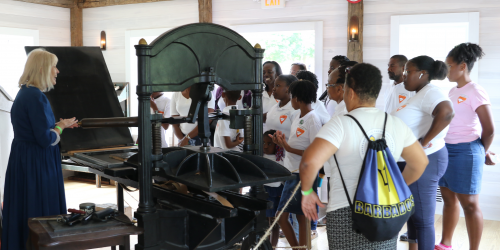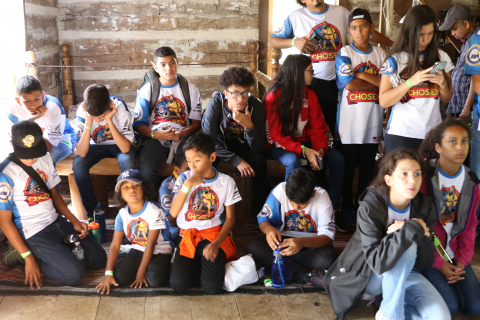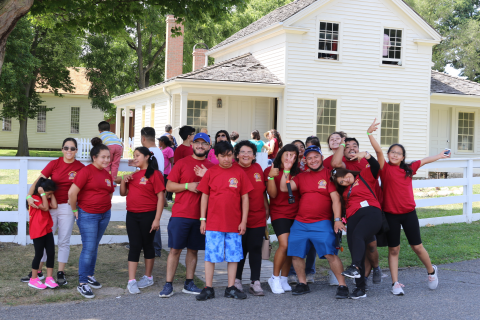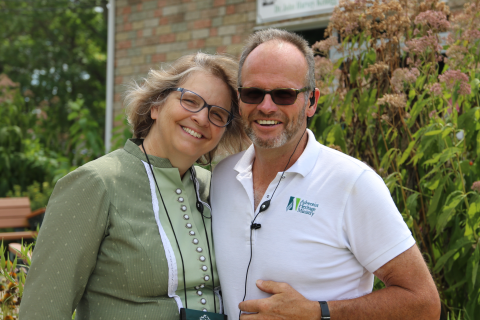
Pathfinders in the replica of the 1855 Publishing House.
During a three-week span in August, 6,253 Pathfinders from around the world traveled to the Historical Adventist Village in Battle Creek, Mich., on their way to and from “Chosen,” the 2019 International Pathfinder Camporee in Oshkosh, Wis. Some clubs came from the farthest corners of the world like South Korea, Papua New Guinea, Latvia, Russia, Estonia, Belgium, Brazil, Peru, Mexico, Dominican Republic, England, Argentina, Austria, Australia, Italy and Canada, and others not so far away, like those from the U.S., including: California, Maine, Florida, Louisiana, Texas, Massachusetts, Pennsylvania, Oregon and Washington. From as early as 8 a.m. until as late as 10 p.m., the Pathfinders came to hear the many stories of the roots of Adventism that run deep in Battle Creek.
At HAV, they learned that in 1855 four men — J.P. Kellogg, Dan Palmer, Cyrenius Smith and Henry Lyon — invited James White to move the publishing work to Battle Creek and provided $1,250 to purchase a piece of land and erect a building to house the publishing work.
Pathfinders were amazed to learn the John Loughborough was only 16 years old when he started preaching the message of a soon coming Savior.
In the Hardy House Exhibit, these young Adventist learned that Edson White built the boat Morning Star in Allegan, Mich., so he could do missionary work in the South that led to the establishment of what is now called Oakwood University.
Many Pathfinders attend one of our modern-day Adventist schools. So, the visit to the one-room schoolhouse informed them that Goodloe Harper Bell was instrumental in the establishment of the Adventist school system in Battle Creek in 1872.
At the next stop on the tour of the village, Pathfinders visited the actual Parkville Church and heard the exciting story of Ellen White’s Civil War vision and how she did not breathe for twenty minutes while in that vision.
David Hewitt, the “most honest man in all of Battle Creek,” lived in a log cabin very much like the one the Pathfinders walked through in the Village. While in that very cabin, they received the knowledge that Hewitt learned the great Adventist message from Elder Joseph Bates because Bates had had a dream that he should share that message with the most honest man in town.

Sometimes, the young people learned, folks like to hang onto their old beliefs. Such was the case with Deacon White, the father of James White. It wasn’t until he was well along in age and lived in his little cottage across the street from his son and his wife, Ellen, that he accepted the seventh-day Sabbath truth.
The second to last stop of the Village tour is the replica of the Second Meeting House. Many historically important events of the Adventist Church occurred in that Meeting House. Among them was the choosing of the name “Seventh-day Adventist” in October 1860.
The last stop on the Village trek is the home of Ellen and James White. The only home where James and Ellen lived with all four of their sons, Pathfinders were able to walk in the steps of the Whites in their own home. Although their youngest son died in that home in Battle Creek, James and Ellen continued to serve the Lord through their personal pain and heartache.

This huge Pathfinder tour undertaking was carefully and expertly organized by the HAV caretaker/managers, Betty and Don Scherencel. They requisitioned numerous volunteers from as far away as Arkansas and California. Tours were provided in both Spanish and English while others were translated by Club members in their own native tongue. All in all, these three weeks of bustle with so many of God’s children was really just a little taste of heaven while we travel this path on our course to eternity.
